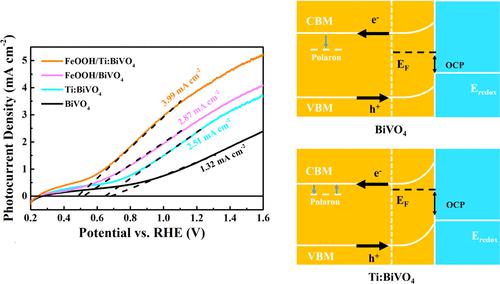当前位置:
X-MOL 学术
›
ACS Appl. Mater. Interfaces
›
论文详情
Our official English website, www.x-mol.net, welcomes your
feedback! (Note: you will need to create a separate account there.)
Unconventional Substitution for BiVO4 to Enhance Photoelectrocatalytic Performance by Accelerating Polaron Hopping
ACS Applied Materials & Interfaces ( IF 8.3 ) Pub Date : 2023-03-07 , DOI: 10.1021/acsami.2c23169
Jiachen Wang 1 , Jing Bai 1 , Yan Zhang 1 , Lei Li 1 , Changhui Zhou 1 , Tingsheng Zhou 1 , Jinhua Li 1 , Hong Zhu 2 , Baoxue Zhou 1, 3
ACS Applied Materials & Interfaces ( IF 8.3 ) Pub Date : 2023-03-07 , DOI: 10.1021/acsami.2c23169
Jiachen Wang 1 , Jing Bai 1 , Yan Zhang 1 , Lei Li 1 , Changhui Zhou 1 , Tingsheng Zhou 1 , Jinhua Li 1 , Hong Zhu 2 , Baoxue Zhou 1, 3
Affiliation

|
Bismuth vanadate (BiVO4) as a fascinating semiconductor for photoelectrocatalytic (PEC) water oxidation with suitable band gap (Eg) has been limited by the issue of poor separation and transportation of charge carriers. Herein, we propose an unconventional substitution of V5+ sites by Ti4+ in BiVO4 (Ti:BiVO4) for the similar ionic radii and accelerated polaron hopping. Ti:BiVO4 increased the photocurrent density 1.90 times up to 2.51 mA cm–2 at 1.23 V vs RHE and increased the charge carrier density 1.81 times to 5.86 × 1018 cm–3. Compared with bare BiVO4, Ti:BiVO4 improves the bulk separation efficiency to 88.3% at 1.23 V vs RHE. The DFT calculations have illustrated that Ti-doping modification could decrease the polaron hopping energy barrier, narrow the Eg, and decrease the overpotential of the oxygen evolution reaction (OER) concurrently. With further spin-coated FeOOH cocatalyst, the photoanode has a photocurrent density of 3.99 mA cm–2 at 1.23 V vs RHE. The excellent PEC performance of FeOOH/Ti:BiVO4 is attributed to the synergistic effect of the FeOOH layer and Ti doping, which could promote charge carrier separation and transfer by expediting polaron migration.
中文翻译:

BiVO4 的非常规替代通过加速极化子跳跃来增强光电催化性能
钒酸铋(BiVO 4 )作为一种具有合适带隙( E g )的用于光电催化(PEC)水氧化的迷人半导体,一直受到电荷载流子分离和传输不良问题的限制。在此,我们提出在BiVO 4 (Ti:BiVO 4 ) 中用Ti 4+非常规地取代V 5+位点,以获得相似的离子半径和加速极化子跳跃。 Ti:BiVO 4在1.23 V vs RHE下将光电流密度提高1.90倍,达到2.51 mA cm –2 ,并将载流子密度提高1.81倍,达到5.86 × 10 18 cm –3 。与裸BiVO 4相比,Ti:BiVO 4在1.23 V vs RHE下将体分离效率提高至88.3%。 DFT计算表明Ti掺杂改性可以降低极化子跳跃能垒,缩小E g ,同时降低析氧反应(OER)的过电势。通过进一步旋涂 FeOOH 助催化剂,光电阳极在 1.23 V vs RHE 下的光电流密度为 3.99 mA cm –2 。 FeOOH/Ti:BiVO 4优异的PEC性能归因于FeOOH层和Ti掺杂的协同效应,它可以通过加速极化子迁移来促进载流子分离和转移。
更新日期:2023-03-07
中文翻译:

BiVO4 的非常规替代通过加速极化子跳跃来增强光电催化性能
钒酸铋(BiVO 4 )作为一种具有合适带隙( E g )的用于光电催化(PEC)水氧化的迷人半导体,一直受到电荷载流子分离和传输不良问题的限制。在此,我们提出在BiVO 4 (Ti:BiVO 4 ) 中用Ti 4+非常规地取代V 5+位点,以获得相似的离子半径和加速极化子跳跃。 Ti:BiVO 4在1.23 V vs RHE下将光电流密度提高1.90倍,达到2.51 mA cm –2 ,并将载流子密度提高1.81倍,达到5.86 × 10 18 cm –3 。与裸BiVO 4相比,Ti:BiVO 4在1.23 V vs RHE下将体分离效率提高至88.3%。 DFT计算表明Ti掺杂改性可以降低极化子跳跃能垒,缩小E g ,同时降低析氧反应(OER)的过电势。通过进一步旋涂 FeOOH 助催化剂,光电阳极在 1.23 V vs RHE 下的光电流密度为 3.99 mA cm –2 。 FeOOH/Ti:BiVO 4优异的PEC性能归因于FeOOH层和Ti掺杂的协同效应,它可以通过加速极化子迁移来促进载流子分离和转移。

































 京公网安备 11010802027423号
京公网安备 11010802027423号